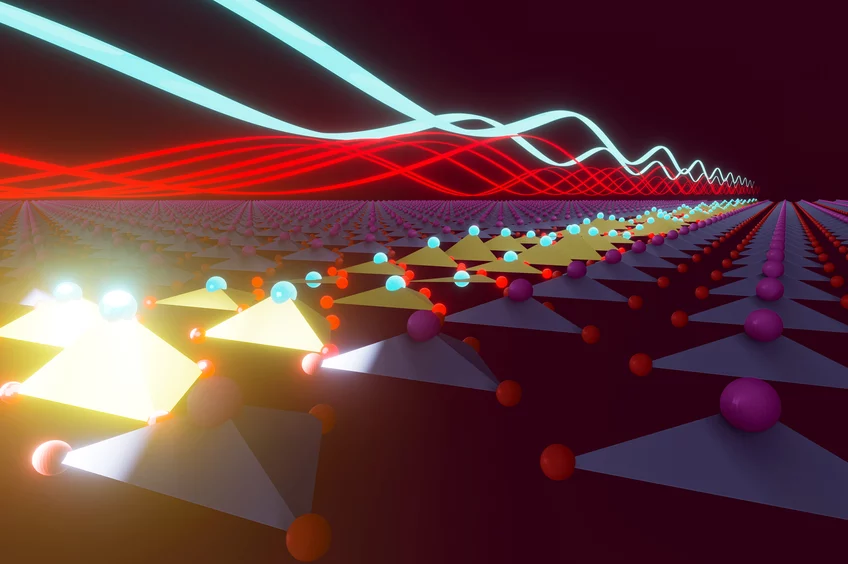When mid-infrared laser pulses collide with certain complex materials, their fundamental properties can shift dramatically. They could become magnetic, ferroelectric or capable of carrying electrical currents without resistance.
 An intense mid-infrared laser pulse hits a ferroelectric LiNbO3 crystal and kicks atomic vibrations only in a short depth below the surface, emphasized by the bright tetrahedra. Through anharmonic coupling, this strong vibration launches a polarization wave, also called polariton, which propagates throughout the remaining depth of the crystal to modulate the ferroelectric polarization. Image Credit: © Jörg Harms, MPSD.
An intense mid-infrared laser pulse hits a ferroelectric LiNbO3 crystal and kicks atomic vibrations only in a short depth below the surface, emphasized by the bright tetrahedra. Through anharmonic coupling, this strong vibration launches a polarization wave, also called polariton, which propagates throughout the remaining depth of the crystal to modulate the ferroelectric polarization. Image Credit: © Jörg Harms, MPSD.
The main ingredient of such phenomena is the effective excitation of the collective atomic motions of the solids, called phonons. Normally, the periodically aligned atoms of the crystal lattice only tend to vibrate around their equilibrium positions.
But in the case of extremely intense excitation fields, they will vibrate at colossal amplitudes, with the consequence of displacing atoms away from their equilibrium positions, and through this method, magnetic or electronic or functionality can be altered. This phenomenon is referred to as nonlinear phononics.
Nonlinear phononics was previously thought to occur only within the small region of the crystal where mid-infrared light pulses exist.
At present, scientists in Hamburg have found that the ferroelectric polarization of lithium niobate (LiNbO3) also varies in areas that are well away from the direct “hit” of the laser pulse, with the polarization reversal occurring across the entire crystal. The team’s study of this hitherto unidentified phenomenon known as nonlocal nonlinear phononics has been reported in the Nature Physics journal.
Ferroelectric materials like LiNbO3 hold a static electric polarization produced by lines of positive and negative charge that can be changed with an electric field. This special property makes these materials the fundamental building blocks of several modern electronic components used in laptops, smartphones and ultrasound imaging devices.
A new method using laser light to alter the ferroelectric polarization has been discovered, and it enables extremely rapid processes to take place. This would be a major step in the development of highly effective ultrafast optical switches for new devices.
The scientists in Andrea Cavalleri’s group at the Max Planck Institute for the Structure and Dynamics (MPSD) utilized mid-infrared pulses to excite the surface of a LiNbO3 crystal. This initiates a powerful vibration across a region that spans a depth of 3 μm from the surface of the crystal.
Furthermore, the researchers made use of a method known as femtosecond-stimulated Raman scattering to quantify ultrafast changes in the ferroelectric polarization across the entire 50 μm crystal thickness. The measurements disclosed that light pulses with an extremely high energy density make the ferroelectric polarization reverse throughout the complete crystal.
Simulating the effects of nonlinear phononics in LiNbO3 by utilizing computational methods, the authors discovered that strong polarization waves known as polaritons arise from the small volume traversed by the light pulse and move across the leftover depth of the crystal.
Such polariton waves are believed to play a major role in changing the ferroelectric polarization across the sections of the crystal that are untouched by the light pulse.
The study outcomes reported by Henstridge et al. add an interesting new piece to the elusive puzzle of ultrafast ferroelectricity. This understanding can result in new device components like sustainable optical switches.
At a larger scale, this work raises a big question concerning if past and future systems that are driven by nonlinear phononics could display a similar type of nonlocal character. The potential to manipulate functional properties at a distance could help extend the realm of opportunities for integrating nonlinear phononics into combined devices and other complicated materials. This helps in setting the stage for new avenues for controlling systems with light.
This study was financially supported by the Deutsche Forschungsgemeinschaft through the Cluster of Excellence CUI : Advanced Imaging of Matter.
Journal Reference:
Henstridge, M., et al. (2022) Nonlocal nonlinear phononics. Nature Physics. doi.org/10.1038/s41567-022-01512-3.